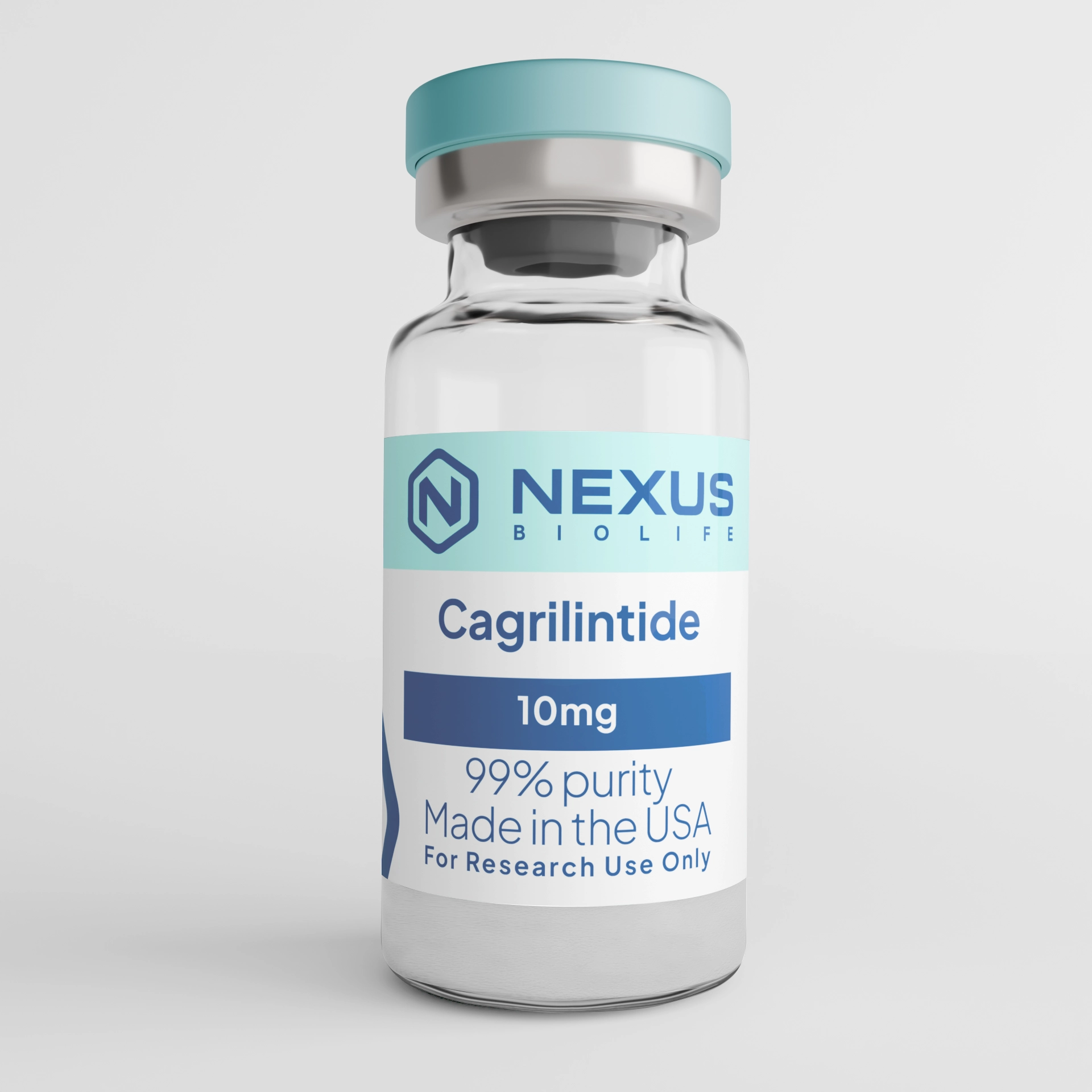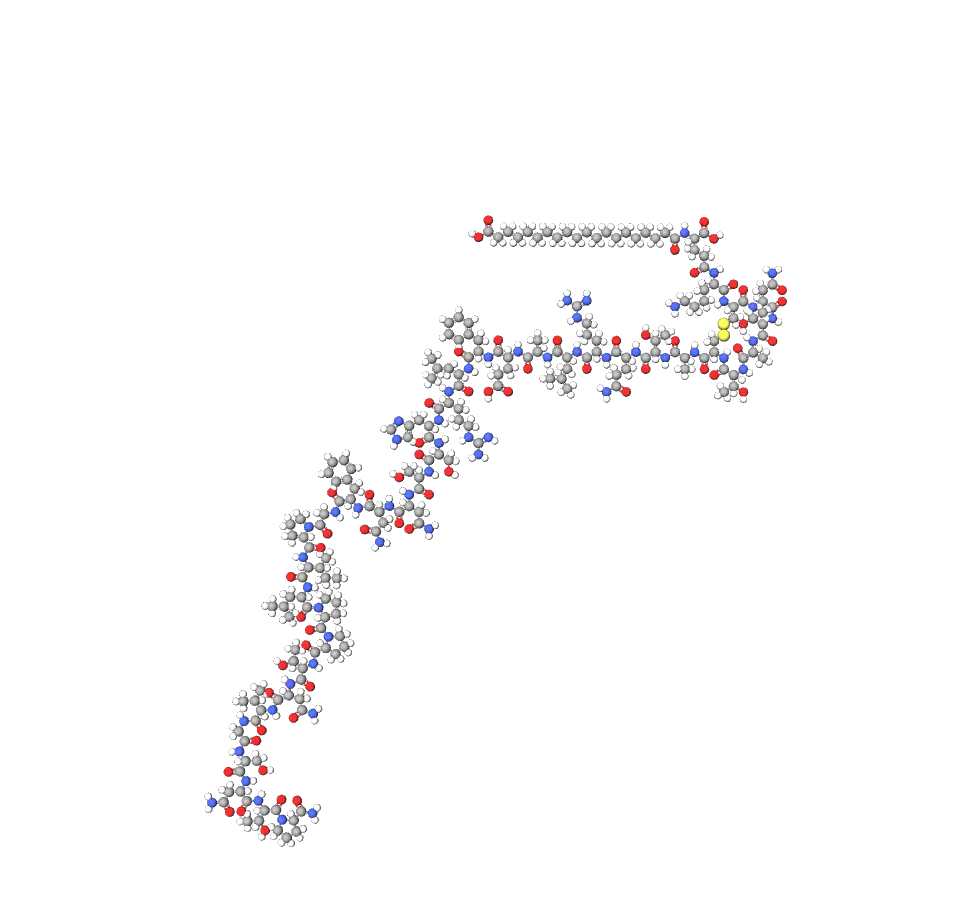
Cagrilintide is a synthetic peptide meticulously prepared for scientific inquiry. This product is synthesized with high purity for laboratory investigations. It is developed for use in various research applications. Cagrilintide is designated solely for research and development purposes.

At its core, cagrilintide shares structural similarities with human amylin, a 37-amino-acid peptide secreted by pancreatic beta cells alongside insulin. However, targeted modifications in cagrilintide's sequence—such as lipidation and amino acid substitutions—confer greater resistance to enzymatic degradation and extend its half-life, allowing for sustained activity in experimental models. These changes also minimize the formation of amyloid fibrils, a common issue with native amylin that can complicate handling in lab settings. In terms of molecular pharmacology, cagrilintide binds to amylin receptors (AMYRs), which are complexes formed by the calcitonin receptor (CTR) and receptor activity-modifying proteins (RAMPs), particularly AMYR1 and AMYR3 in the central nervous system. This binding profile results in distinct conformational dynamics compared to other peptides, potentially influencing downstream signaling pathways in unique ways that researchers can probe.
From a practical standpoint, cagrilintide is typically supplied as a lyophilized powder, requiring reconstitution with sterile water or buffer solutions for in-vitro assays. Its enhanced stability means it can withstand storage conditions better than native amylin, but we always recommend following best practices: store at -20°C or below, avoid repeated freeze-thaw cycles, and use within recommended timelines to maintain integrity. Our commitment to quality ensures each batch undergoes rigorous testing for purity, typically exceeding 95% as confirmed by HPLC and mass spectrometry, so you can focus on your experiments with confidence.
Cagrilintide is a long-acting synthetic analog of the naturally occurring peptide hormone amylin, engineered to enhance stability and duration of action for investigative purposes in metabolic research. As a non-selective amylin receptor agonist, it mimics amylin's physiological roles while offering improved solubility and reduced tendency for aggregation, making it a valuable tool for in-vitro studies exploring appetite regulation, energy balance, and glucose homeostasis. Remember, all our peptides, including cagrilintide, are strictly for research and in-vitro use only—not intended for human consumption or any diagnostic or therapeutic applications.
Diving deeper into how cagrilintide works, it primarily acts through amylin receptors in the brain and periphery to modulate metabolic processes. Amylin itself is known for suppressing glucagon secretion from alpha cells, slowing gastric emptying, boosting energy expenditure, and promoting satiety signals in the hypothalamus—effects that cagrilintide replicates and amplifies due to its prolonged action. In research models, activation of these pathways has been shown to reduce food intake and body weight without relying solely on insulin-dependent mechanisms, offering a complementary angle to other peptide-based studies.
One intriguing aspect is its potential synergy with other agents, such as glucagon-like peptide-1 (GLP-1) receptor agonists. In combined formulations like those explored in investigative settings, cagrilintide contributes to attenuated metabolic adaptation, meaning it helps sustain energy expenditure during caloric restriction—a key factor in long-term metabolic studies. This dual agonism approach highlights cagrilintide's role in mimicking interorgan crosstalk, where peptides like amylin facilitate communication between the pancreas, gut, brain, and adipose tissue. For instance, in cell-based assays, cagrilintide can be used to study how amylin signaling influences mitochondrial function or inflammatory responses, providing insights into broader endocrine networks. We're passionate about demystifying these mechanisms; think of cagrilintide as a precise probe for dissecting how the body regulates energy homeostasis at a molecular level.
In summary, cagrilintide stands out as a robust tool for advancing our understanding of metabolic regulation through its refined amylin-like actions and enhanced pharmacological profile. Whether you're delving into satiety signaling, energy expenditure, or multi-hormone synergies, it offers a dependable means to generate meaningful data in controlled research environments. At our core, we're driven by a commitment to quality and education, providing peptides like this to foster innovation while upholding the highest standards of integrity. Remember, cagrilintide is exclusively for in-vitro research—not for human use—and we're always here as your approachable partner to discuss how it might fit into your projects. Let's keep pushing the boundaries of science together, one experiment at a time.
Cagrilintide's versatility shines in various in-vitro and ex-vivo research contexts, particularly in the fields of obesity, type 2 diabetes, and metabolic syndrome modeling. Researchers often employ it to investigate appetite suppression pathways, using cell lines like hypothalamic neurons or adipocytes to measure changes in gene expression related to satiety hormones. Its long-acting nature makes it ideal for time-course experiments, where sustained receptor activation can reveal chronic effects on cellular metabolism that shorter-acting analogs might miss.
In obesity-related studies, cagrilintide serves as a tool to explore weight loss mechanisms independent of or in tandem with GLP-1 pathways. For example, combinations with semaglutide analogs have been modeled in vitro to assess additive effects on energy intake and expenditure, demonstrating superior outcomes in simulated metabolic environments. Beyond weight management, its amylin-mimetic properties open doors to cardiovascular and neuroendocrine research, as amylin analogs like cagrilintide may influence vascular tone or stress responses in isolated tissue preparations.
We also see it applied in peptide pharmacology screens, where scientists compare its binding affinity and efficacy against other G protein-coupled receptor agonists to optimize drug-like properties. Safety in handling is paramount—always use appropriate PPE and dispose of materials per lab protocols. Our team is here to support your work with educational resources, like guides on reconstitution or assay optimization, because we believe empowering researchers leads to better science.
To get the most out of cagrilintide in your experiments, proper handling is key. Upon arrival, inspect the vial for integrity and store immediately in a freezer. For reconstitution, we suggest using bacteriostatic water or a neutral pH buffer to achieve concentrations suitable for your assays, typically 1-5 mg/mL. Avoid vortexing to prevent potential denaturation; gentle swirling or inversion works best. Once prepared, solutions can be aliquoted and frozen for short-term use, but fresh preparations yield the most reliable results.
In terms of stability, cagrilintide's modifications make it more forgiving than native peptides, but exposure to light, heat, or pH extremes can still degrade it. We test for these factors in our quality assurance process, ensuring you receive a product that's ready for precise, reproducible work.
Cagrilintide is a long-acting synthetic analog of the naturally occurring peptide hormone amylin, engineered to enhance stability and duration of action for investigative purposes in metabolic research. As a non-selective amylin receptor agonist, it mimics amylin's physiological roles while offering improved solubility and reduced tendency for aggregation, making it a valuable tool for in-vitro studies exploring appetite regulation, energy balance, and glucose homeostasis. Remember, all our peptides, including cagrilintide, are strictly for research and in-vitro use only—not intended for human consumption or any diagnostic or therapeutic applications.
Diving deeper into how cagrilintide works, it primarily acts through amylin receptors in the brain and periphery to modulate metabolic processes. Amylin itself is known for suppressing glucagon secretion from alpha cells, slowing gastric emptying, boosting energy expenditure, and promoting satiety signals in the hypothalamus—effects that cagrilintide replicates and amplifies due to its prolonged action. In research models, activation of these pathways has been shown to reduce food intake and body weight without relying solely on insulin-dependent mechanisms, offering a complementary angle to other peptide-based studies.
One intriguing aspect is its potential synergy with other agents, such as glucagon-like peptide-1 (GLP-1) receptor agonists. In combined formulations like those explored in investigative settings, cagrilintide contributes to attenuated metabolic adaptation, meaning it helps sustain energy expenditure during caloric restriction—a key factor in long-term metabolic studies. This dual agonism approach highlights cagrilintide's role in mimicking interorgan crosstalk, where peptides like amylin facilitate communication between the pancreas, gut, brain, and adipose tissue. For instance, in cell-based assays, cagrilintide can be used to study how amylin signaling influences mitochondrial function or inflammatory responses, providing insights into broader endocrine networks. We're passionate about demystifying these mechanisms; think of cagrilintide as a precise probe for dissecting how the body regulates energy homeostasis at a molecular level.
In summary, cagrilintide stands out as a robust tool for advancing our understanding of metabolic regulation through its refined amylin-like actions and enhanced pharmacological profile. Whether you're delving into satiety signaling, energy expenditure, or multi-hormone synergies, it offers a dependable means to generate meaningful data in controlled research environments. At our core, we're driven by a commitment to quality and education, providing peptides like this to foster innovation while upholding the highest standards of integrity. Remember, cagrilintide is exclusively for in-vitro research—not for human use—and we're always here as your approachable partner to discuss how it might fit into your projects. Let's keep pushing the boundaries of science together, one experiment at a time.
At its core, cagrilintide shares structural similarities with human amylin, a 37-amino-acid peptide secreted by pancreatic beta cells alongside insulin. However, targeted modifications in cagrilintide's sequence—such as lipidation and amino acid substitutions—confer greater resistance to enzymatic degradation and extend its half-life, allowing for sustained activity in experimental models. These changes also minimize the formation of amyloid fibrils, a common issue with native amylin that can complicate handling in lab settings. In terms of molecular pharmacology, cagrilintide binds to amylin receptors (AMYRs), which are complexes formed by the calcitonin receptor (CTR) and receptor activity-modifying proteins (RAMPs), particularly AMYR1 and AMYR3 in the central nervous system. This binding profile results in distinct conformational dynamics compared to other peptides, potentially influencing downstream signaling pathways in unique ways that researchers can probe.
From a practical standpoint, cagrilintide is typically supplied as a lyophilized powder, requiring reconstitution with sterile water or buffer solutions for in-vitro assays. Its enhanced stability means it can withstand storage conditions better than native amylin, but we always recommend following best practices: store at -20°C or below, avoid repeated freeze-thaw cycles, and use within recommended timelines to maintain integrity. Our commitment to quality ensures each batch undergoes rigorous testing for purity, typically exceeding 95% as confirmed by HPLC and mass spectrometry, so you can focus on your experiments with confidence.

Cagrilintide's versatility shines in various in-vitro and ex-vivo research contexts, particularly in the fields of obesity, type 2 diabetes, and metabolic syndrome modeling. Researchers often employ it to investigate appetite suppression pathways, using cell lines like hypothalamic neurons or adipocytes to measure changes in gene expression related to satiety hormones. Its long-acting nature makes it ideal for time-course experiments, where sustained receptor activation can reveal chronic effects on cellular metabolism that shorter-acting analogs might miss.
In obesity-related studies, cagrilintide serves as a tool to explore weight loss mechanisms independent of or in tandem with GLP-1 pathways. For example, combinations with semaglutide analogs have been modeled in vitro to assess additive effects on energy intake and expenditure, demonstrating superior outcomes in simulated metabolic environments. Beyond weight management, its amylin-mimetic properties open doors to cardiovascular and neuroendocrine research, as amylin analogs like cagrilintide may influence vascular tone or stress responses in isolated tissue preparations.
We also see it applied in peptide pharmacology screens, where scientists compare its binding affinity and efficacy against other G protein-coupled receptor agonists to optimize drug-like properties. Safety in handling is paramount—always use appropriate PPE and dispose of materials per lab protocols. Our team is here to support your work with educational resources, like guides on reconstitution or assay optimization, because we believe empowering researchers leads to better science.
To get the most out of cagrilintide in your experiments, proper handling is key. Upon arrival, inspect the vial for integrity and store immediately in a freezer. For reconstitution, we suggest using bacteriostatic water or a neutral pH buffer to achieve concentrations suitable for your assays, typically 1-5 mg/mL. Avoid vortexing to prevent potential denaturation; gentle swirling or inversion works best. Once prepared, solutions can be aliquoted and frozen for short-term use, but fresh preparations yield the most reliable results.
In terms of stability, cagrilintide's modifications make it more forgiving than native peptides, but exposure to light, heat, or pH extremes can still degrade it. We test for these factors in our quality assurance process, ensuring you receive a product that's ready for precise, reproducible work.
